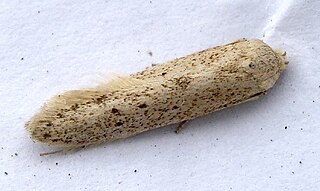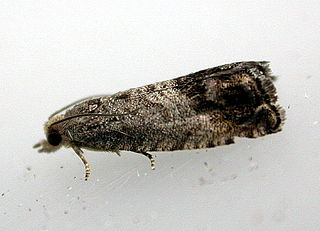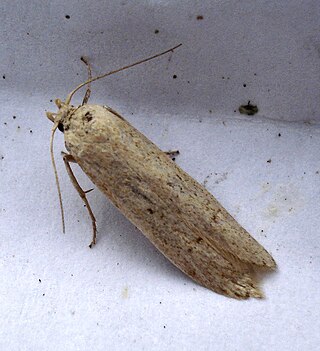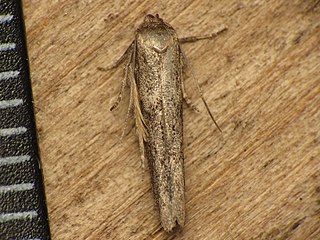
The Blastobasidae are a family of moths in the superfamily Gelechioidea. Its species can be found almost anywhere in the world, though in some places they are not native but introduced by humans. In some arrangements, these moths are included in the case-bearer family (Coleophoridae) as subfamily Blastobasinae. The Symmocidae are sometimes included in the Blastobasidae as subfamily or tribe.

Blastobasis is the type genus of the gelechioid moth family Blastobasidae; in some arrangements these are placed in the case-bearer family (Coleophoridae) as a subfamily. Within the Blastobasidae, the subfamily Blastobasinae has been established to distinguish the Blastobasis lineage from the group around Holcocera, but the delimitation is not yet well-resolved.

Cydia splendana, the chestnut tortrix, is a moth of the family Tortricidae. It is found in Europe. It is also known as the acorn moth, but this can also refer to Blastobasis glandulella from North America, which belongs to the more primitive family Blastobasidae.

Blastobasis adustella is a species of moth of the family Blastobasidae. It is endemic to Australian region, but was introduced in western Europe and is now reported from The Netherlands, Great Britain, Ireland, Madeira and the Azores

Blastobasis lacticolella is a species of moth of the family Blastobasidae. It was introduced to western Europe and is now reported from the Netherlands, Great Britain, Ireland and Madeira.
Blastobasis vittata is a moth of the family Blastobasidae. It was thought to be endemic to Madeira but is now known to inhabit the Netherlands, France, the Channel Islands, England and Northern Ireland.

Blastobasis glandulella is a species of moth of the family Blastobasidae. It is found in the Eastern United States and southern Ontario, Canada. It has also been recorded in California. In Europe, it has been recorded from Austria, Germany, the Czech Republic, Italy, Slovakia and Croatia.
Blastobasis beo is a moth in the family Blastobasidae. It is found in Costa Rica.
Blastobasis repartella is a moth in the family Blastobasidae. It is found in the United States, including Colorado, Maine, South Dakota and Illinois.

Blastobasis phycidella is a moth in the family Blastobasidae. It is found in most of Europe.
Blastobasis aynekiella is a moth in the family Blastobasidae. It is found in Kenya. The habitat consists of the western highlands of the Kakamega Forest.
Blastobasis elgonae is a moth in the family Blastobasidae. It is found in Kenya, where it is known from Mount Elgon in the western highlands.
Blastobasis determinata is a moth in the family Blastobasidae. It is found in South Africa.
Blastobasis mpala is a moth in the family Blastobasidae. It is found in Kenya, where it is known from savanna habitat in the central highlands.
Blastobasis spectabilella is a moth in the family Blastobasidae. It is found on Madeira.
Blastobasis moffetti is a moth in the family Blastobasidae that is endemic to New Caledonia.
Blastobasis indirecta is a moth in the family Blastobasidae. It was described by Edward Meyrick in 1935. It is endemic to Taiwan.
Blastobasis nephelophaea is a moth in the family Blastobasidae. It was described by Edward Meyrick in 1931. It is endemic to Taiwan.
Blastobasis trachelista is a moth in the family Blastobasidae. It was described by Edward Meyrick in 1921. It is found in Zimbabwe.






